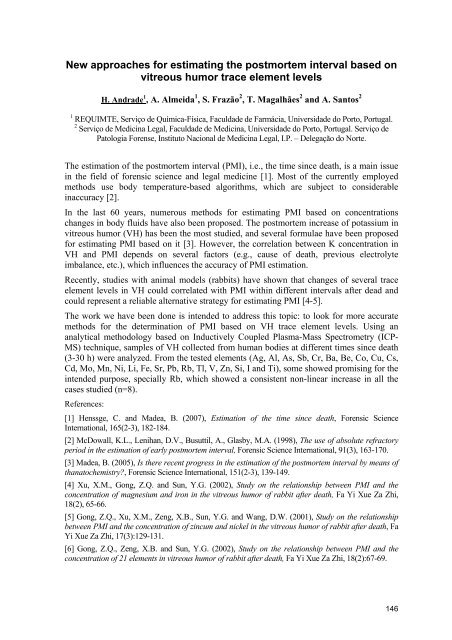IJUP08 - Universidade do Porto
IJUP08 - Universidade do Porto
IJUP08 - Universidade do Porto
- TAGS
- universidade
- porto
- ijup.up.pt
You also want an ePaper? Increase the reach of your titles
YUMPU automatically turns print PDFs into web optimized ePapers that Google loves.
New approaches for estimating the postmortem interval based on<br />
vitreous humor trace element levels<br />
H. Andrade 1 , A. Almeida 1 , S. Frazão 2 , T. Magalhães 2 and A. Santos 2<br />
1 REQUIMTE, Serviço de Química-Física, Faculdade de Farmácia, <strong>Universidade</strong> <strong>do</strong> <strong>Porto</strong>, Portugal.<br />
2 Serviço de Medicina Legal, Faculdade de Medicina, <strong>Universidade</strong> <strong>do</strong> <strong>Porto</strong>, Portugal. Serviço de<br />
Patologia Forense, Instituto Nacional de Medicina Legal, I.P. – Delegação <strong>do</strong> Norte.<br />
The estimation of the postmortem interval (PMI), i.e., the time since death, is a main issue<br />
in the field of forensic science and legal medicine [1]. Most of the currently employed<br />
methods use body temperature-based algorithms, which are subject to considerable<br />
inaccuracy [2].<br />
In the last 60 years, numerous methods for estimating PMI based on concentrations<br />
changes in body fluids have also been proposed. The postmortem increase of potassium in<br />
vitreous humor (VH) has been the most studied, and several formulae have been proposed<br />
for estimating PMI based on it [3]. However, the correlation between K concentration in<br />
VH and PMI depends on several factors (e.g., cause of death, previous electrolyte<br />
imbalance, etc.), which influences the accuracy of PMI estimation.<br />
Recently, studies with animal models (rabbits) have shown that changes of several trace<br />
element levels in VH could correlated with PMI within different intervals after dead and<br />
could represent a reliable alternative strategy for estimating PMI [4-5].<br />
The work we have been <strong>do</strong>ne is intended to address this topic: to look for more accurate<br />
methods for the determination of PMI based on VH trace element levels. Using an<br />
analytical metho<strong>do</strong>logy based on Inductively Coupled Plasma-Mass Spectrometry (ICP-<br />
MS) technique, samples of VH collected from human bodies at different times since death<br />
(3-30 h) were analyzed. From the tested elements (Ag, Al, As, Sb, Cr, Ba, Be, Co, Cu, Cs,<br />
Cd, Mo, Mn, Ni, Li, Fe, Sr, Pb, Rb, Tl, V, Zn, Si, I and Ti), some showed promising for the<br />
intended purpose, specially Rb, which showed a consistent non-linear increase in all the<br />
cases studied (n=8).<br />
References:<br />
[1] Henssge, C. and Madea, B. (2007), Estimation of the time since death, Forensic Science<br />
International, 165(2-3), 182-184.<br />
[2] McDowall, K.L., Lenihan, D.V., Busuttil, A., Glasby, M.A. (1998), The use of absolute refractory<br />
period in the estimation of early postmortem interval, Forensic Science International, 91(3), 163-170.<br />
[3] Madea, B. (2005), Is there recent progress in the estimation of the postmortem interval by means of<br />
thanatochemistry?, Forensic Science International, 151(2-3), 139-149.<br />
[4] Xu, X.M., Gong, Z.Q. and Sun, Y.G. (2002), Study on the relationship between PMI and the<br />
concentration of magnesium and iron in the vitreous humor of rabbit after death, Fa Yi Xue Za Zhi,<br />
18(2), 65-66.<br />
[5] Gong, Z.Q., Xu, X.M., Zeng, X.B., Sun, Y.G. and Wang, D.W. (2001), Study on the relationship<br />
between PMI and the concentration of zincum and nickel in the vitreous humor of rabbit after death, Fa<br />
Yi Xue Za Zhi, 17(3):129-131.<br />
[6] Gong, Z.Q., Zeng, X.B. and Sun, Y.G. (2002), Study on the relationship between PMI and the<br />
concentration of 21 elements in vitreous humor of rabbit after death, Fa Yi Xue Za Zhi, 18(2):67-69.<br />
146










